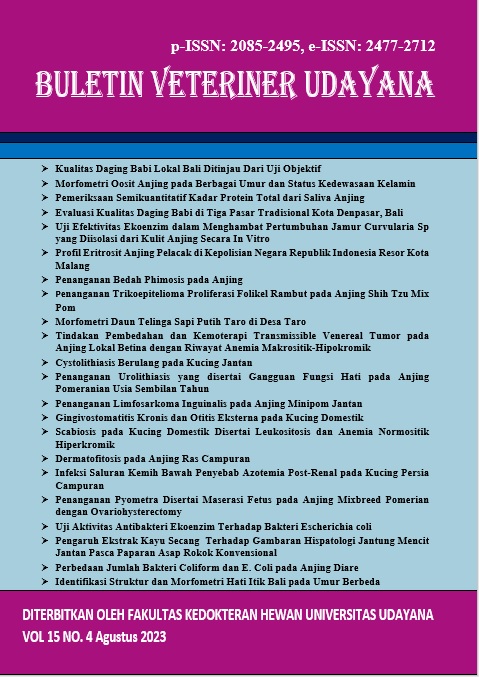DERMATOPHYTOSIS IN MIXED BREED DOG
Abstract
Dermatophytosis is a skin disease caused by dermatophytes yeast. The purpose of examining the case dogs is to determine the agent of the disease that causes many lesions on the dog's skin. The case dog was brought to the Pedungan Vet Care clinic with complaints of skin problems that had been occurring for one month. the case dog is a mixed breed dog aged about one year with a body weight of 12.2 kg and is a rescued dog. On clinical examination there were abnormalities such as lesions consisting of a combination of alopecia, erythema, and crusts. The lesions were found on the ear, face, hind limb, pelvic limb, abdomen, and dorsal part of the body. Then the parts of the lesion were scraped at the edges of the lesion using 10% KOH and a swab. From the results of skin scrapings, the results were negative for dermatophytes. The Wood's lamp examination was negative. On tape smear examination, macroconidia were found in the form of elliptical which were divided into several cells, indicating a positive result of Microsporum sp. Based on the history, physical examination, clinical examination, and laboratory, it can be said that the disease is dermatophytosis. Case dogs were given causative and symptomatic therapy, for causative therapy griseofulvin was given at a dose of 500 mg/kg/bb q.12 hours orally and symptomatic therapy was given the antihistamine chlorpheniramine maleate at a dose of 4 mg/kg/bb q.12 hours orally for 14 days, antiseptic chlorhexidine gluconate 0.05% for cleaning wounds twice a day, and case dogs were bathed with Sebazole® antifungal shampoo twice a week for one month. After seven days of treatment, the pruritus symptoms observed decreased but there were no significant changes for other diseases.
Downloads
References
Ates A, Ilkit M, Ozdemir R, Ozcan K. 2008. Dermatophytes isolated from asymptomatic dogs in Adana, Turkey: A preliminary study. J. Med. Mycol. 18(3):154-157.
Bond R. 2010. Superficial Veterinary Mycoses. Clin. Dermatol. 28: 226–236.
Brilhante RS, Cavalcante CS, Soares-Junior FA, Cordeiro RA, Sidrim JJ, Rocha MFG. 2003. High rate of Microsporum canis feline and canine dermatophytoses in North east Brazil: Epidemiological and diagnostic features. Mycopathologia. 156(4): 303-308.
Chermette R, Ferreiro L, Guillot J. 2008. Dermatophytoses in animals. Mycopathologia. 166(5-6): 385-405.
Dahdah MJ, Scher RK. 2008. Dermatophytes. Cur. Fungal Infect. Rep. 2: 81–86.
Karpiński TM, Szkaradkiewicz AK. 2015. Chlorhexidine–pharmaco-biological activity and application. Eur. Rev. Med. Pharmacol. Sci. 19(7): 1321-1326.
Kotnik T. 2007. Dermatophytoses in domestic animals and their zoonotic potential. Slovenian Vet. Res. 44(3): 63-73.
Mattei AS, Beber MA, Madrid IM. 2014. Dermatophytosis in small animals. SOJ Microbiol. Infect. Dis. 2(3): 1-6.
Miller WH, Craig EG, Campbell KL, Muller GH, Scott DW. 2013. Muller & Kirk’s Small animal dermatology. 7th ed. St. Louis. Elsevier. Pp. 429-438.
Moriello KA. 2004. Treatment of dermatophytosis in dogs and cats: review of published studies. Vet. Dermatol. 15(2): 99-107.
Moriello KA, Coyner K, Paterson S, Mignon B. 2017. Diagnosis and treatment of dermatophytosis in dogs and cats. Vet. Dermatol. 28: 266-308.
Outerbridge CA. 2006. Mycologic disorders of the skin. Clin. Tech. Small Anim. Pract. 21: 128-134.
Soedarto. 2015. Mikrobiologi kedokteran. Jakarta. CV Sagung Seto. Pp. 202-220.
Sparkes AH, Gruffydd-Jones TJ, Shaw SE, Wright AI, Stokes CR. 1993. Epidemiological and diagnostic features of canine and feline dermatophytosis in the United Kingdom from 1956 to 1991. Vet. Rec. 133: 57-60.
Vermout S, Tabart J, Baldo A, Mathy A, Losson B, Mignon B. 2008. Pathogenesis of dermatophytosis. Mycopathologia. 166: 267-275.
Virbac. 2018. Sebazole antibacterial shampoo for dogs and cats. https://au.virbac.com/products/dog-skin/sebazole-antifungal-shampoo [Diakses 28 Juli 2022]
Wahyudi G, Anthara MS, Arjentinia IPGY. 2020. Studi kasus: demodekosis pada anjing jantan muda ras pug umur satu tahun. Indon. Med. Vet. 9(1): 45-53.
Wientarsih L, Noviyanti L, Prasetyo BF, Madyastuti R. 2012. Penggunaan obat untuk hewan-hewan kecil. Bogor. Techno Medica Press. Pp. 83-85.
Wiryana IKS, Damriyasa IM, Dharmawan NS, Arnawa KAA, Dianiyanti K, Harumna D. 2014. Kejadian dermatosis yang tinggi pada anjing jalanan di Bali. J. Vet. 15(2): 217-220.





